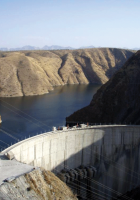
By tapping into the renewable energy generation potential of the country’s rivers, Tekeze increases power stability and provides reliable access to light, heat and water for 80 million people.

By tapping into the renewable energy generation potential of the country’s rivers, Tekeze increases power stability and provides reliable access to light, heat and water for 80 million people.
The project is located on the Tekeze River, a tributary of the Nile, in a remote and mountainous region of Ethiopia. The Tekeze Dam is the tallest in Africa and will generate 300 MW of hydrelectric power, adding 40 percent more energy to the 683 MW previously generated for the entire country. The project was the largest public works project in the country’s history at the time of construction.
The dam is a double curvature (logarithmic spiral) concrete arch dam, a method of design that minimizes the amount of concrete, creating a 70-kilometer-long reservoir. An underground powerhouse, containing four 75 MW Francis Turbines, is located approximately 500 meters downstream from the dam and fed by a 75-meter-high intake structure connected by a 500-meter-long concrete-lined power tunnel. A 105-kilometer-long 230 kV double-circuit transmission line was constructed through rugged, mountainous terrain with minimal environmental impact to connect to the Ethiopian national grid.
Officially inaugurated in November 2009, the project dates back to 1995, when the Ethiopian Ministry of Water Resources conducted a study identifying this as one of two preferred dam sites on the Tekeze River amenable to hydropower development. MWH joined the project in 1998, modifying existing designs for the dam, powerhouse and tunnel system, resulting in significant cost savings.
Beyond serving as a significant renewable energy source, the project has allowed for sustained social and economic growth for Ethiopians. Local community infrastructure was greatly improved as a result of the project, including construction of more than 40 kilometers of roads and the first installation of communications links from the area to the outside world. Education and training was a determined focus during construction, which generated schools, vocational facilities and training programs for local workers.
Due to the lack of natural resources and the cost of imported fuels, power generation in Ethiopia comes primarily from hydroelectric sources. By tapping into the significant energy generation potential of the country’s rivers, this facility is a low-cost way to increase power stability and provide access to light, heat and water in a country that has been forced to impose regular blackouts for its 80 million residents due to severe energy shortages.